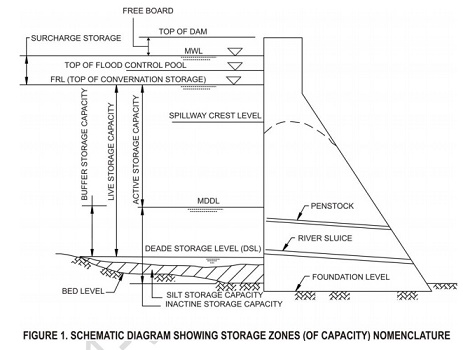Chapter: Civil : Water Resources and Irrigation Engineering : Reservoir Planning and Management
Fixation of Storage capacity
Instructional
objectives
On
completion of this lesson, the student shall learn:
1.
The usual classification of the zones of
a reservoir
2.
The primary types of reservoirs and
their functions
3.
The steps for planning reservoirs
4.
Effect of sedimentation in reservoirs
5.
What are the geological explorations
required to be carried out for reservoirs
6.
How to determine the capacities of
reservoirs
7.
How to determine the dead, live and
flood storages of reservoirs
8.
How to reduce the loss of water from
reservoirs
9.
How to control sedimentation of
reservoirs
10.
The principles to be followed for reservoir
operations
Introduction
Water storage reservoirs may be created
by constructing a dam across a river, along with suitable appurtenant
structures. How ever, in that lesson not much was discussed about fixing the
size of reservoir based on the demand for which it is being constructed. ![]()
Further, reservoirs are
also meant to absorb a part of flood water and the excess is discharged through
a spillway.
It is also essential to
study the relation between flood discharge, reservoirs capacity and spillway
size in order to propose an economic solution to the whole project.
These and topics on reservoir
sedimentation have been discussed in this lesson which shall give an idea as to
how a reservoir should be built and optimally operated.
Fundamentally, a reservoir serves to
store water and the size of the reservoir is governed by the volume of the
water that must be stored, which in turn is affected by the variability of the
inflow available for the reservoir.
Reservoirs are of two
main categories: (a) Impounding reservoirs into which a river flows naturally,
and (b) Service or balancing reservoirs receiving supplies that are pumped or
channeled into them artificially.
In general, service or balancing
reservoirs are required to balance supply with demand. Reservoirs of the second
type are relatively small in volume because the storage required by them is to
balance flows for a few hours or a few days at the most.
Impounding or storage reservoirs are
intended to accumulate a part of the flood flow of the river for use during the
non-flood months.
In
this lesson, our discussions would be centered on these types of reservoirs
Reservoir storage zone
and uses of reservoir
The storage capacity in a reservoir is
nationally divided into three or four parts (Figure 1) distinguished by
corresponding levels.
Full
Reservoir Level (FRL): It
is the level corresponding to the storage which includes both inactive
and active storages and also the flood storage, if provided for. In fact, this
is the highest reservoir level that can be maintained without spillway
discharge or without passing water downstream through sluice ways.
Minimum
Drawdown Level (MDDL): It
is the level below which the reservoir will not be drawn down so
as to maintain a minimum head required in power projects.
Dead
Storage Level (DSL): Below
the level, there are no outlets to drain the water in the reservoir
by gravity.
Maximum
Water Level (MWL): This
id the water level that is ever likely to be attained during the
passage of the design flood. It depends upon the specified initial reservoir
level and the spillway gate operation rule. This level is also called sometimes
as the Highest Reservoir Level or the Highest Flood Level.
Live
storage: This
is the storage available for the intended purpose between Full Supply Level
and the Invert Level of the lowest discharge outlet. The Full Supply
Level is normally that level above which over spill to waste would take place.
The minimum operating level must be sufficiently above the lowest discharge
outlet to avoid vortex formation and air entrainment. This may also be termed
as the volume of water actually available at any time between the Dead Storage
Level and the lower of the actual water level and Full Reservoir Level.
Dead
storage: It
is the total storage below the invert level of the lowest discharge outlet from
the reservoir. It may be available to contain sedimentation,
provided the sediment does not adversely affect the lowest discharge.
Outlet
Surcharge or Flood storage: This
is required as a reserve between Full Reservoir Level and the
Maximum Water level to contain the peaks of floods that might occur when there
is insufficient storage capacity for them below Full Reservoir Level.
Some other terms
related to reservoirs are defined as follows:
Buffer
Storage: This
is the space located just above the Dead Storage Level up to Minimum Drawdown
Level. As the name implies, this zone is a buffer between the active and dead
storage zones and releases from this zone are made in dry situations to cater
for essential requirements only. Dead Storage and Buffer Storage together is
called Interactive Storage.
Within-the-Year
Storage: This
term is used to denote the storage of a reservoir meant for meeting
the demands of a specific hydrologic year used for planning the project.
Carry-Over
Storage: When
the entire water stored in a reservoir is not used up in a year, the unused
water is stored as carry-over storage for use in subsequent years.
Silt
/ Sedimentation zones: The
space occupied by the sediment in the reservoir can be divided into
separate zones. A schematic diagram showing these zones is illustrated in
Figure 2 (as defined in IS: 5477).
Freeboard:
It
is the margin kept for safety between the level at which the dam would be
overtopped and the maximum still water level. This is required to allow
for settlement of the dam, for wave run up above still water level and for
unforeseen rises in water level, because of surges resulting from landslides
into the reservoir from the peripheral hills, earthquakes or unforeseen floods
or operational deficiencies.

Related Topics